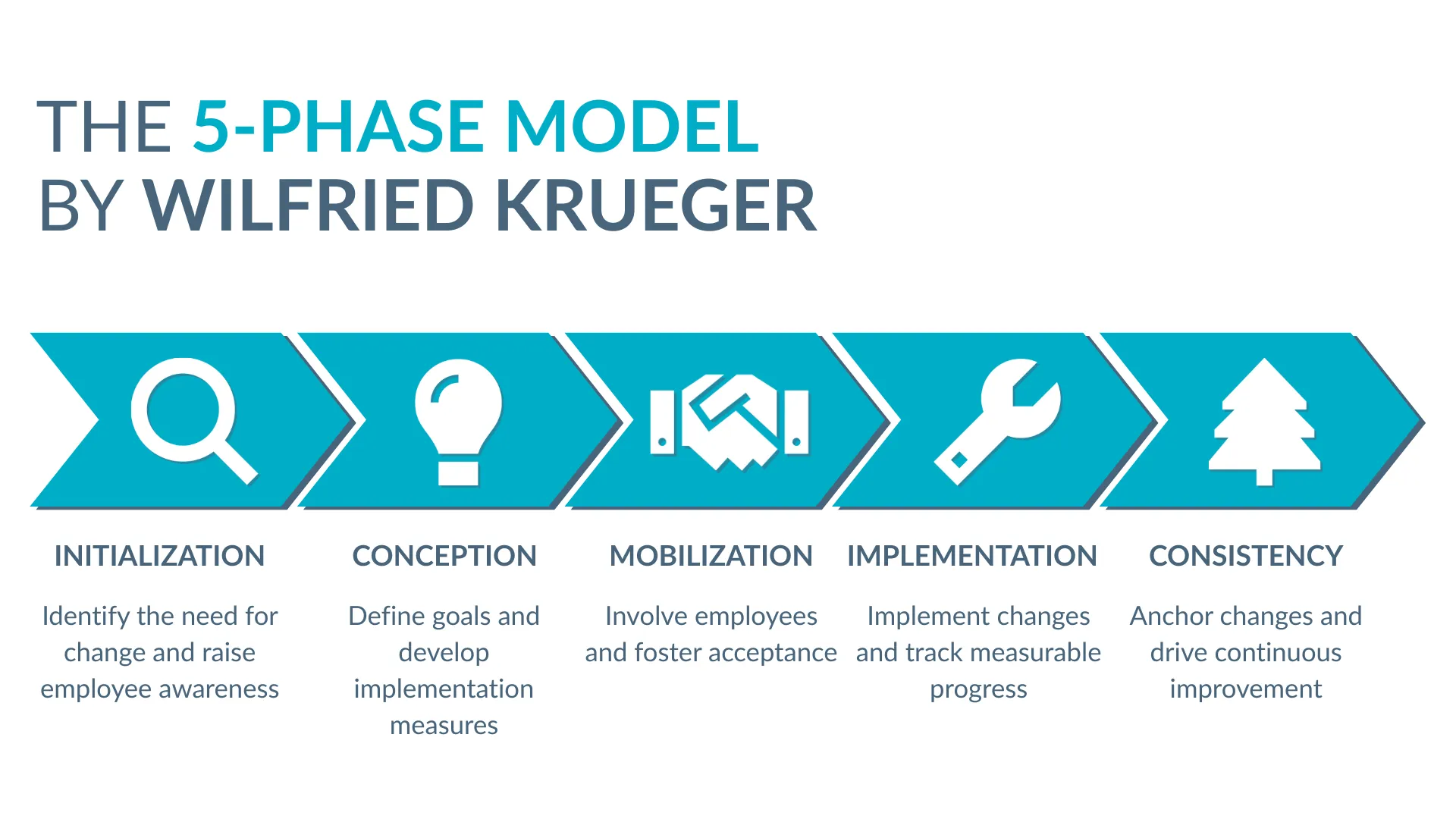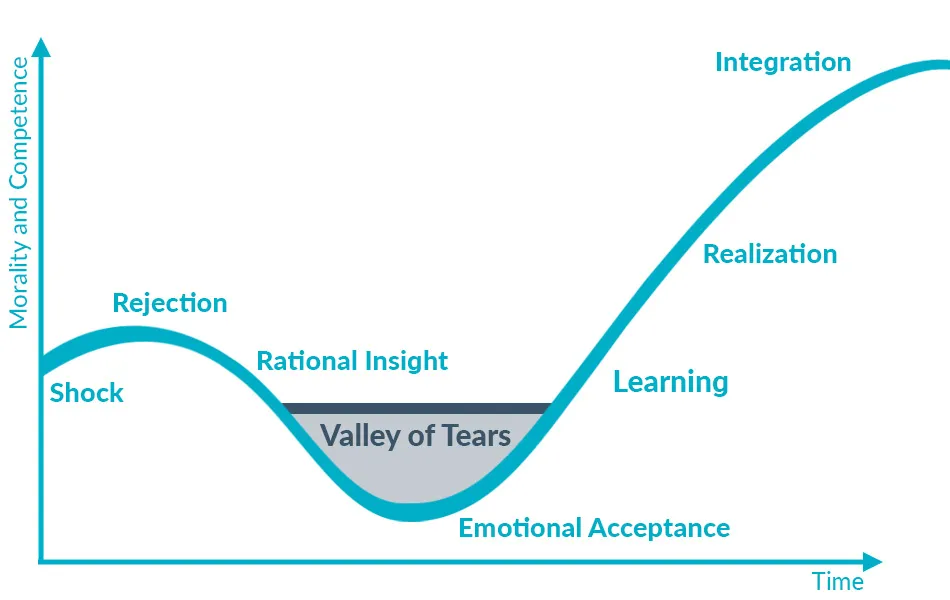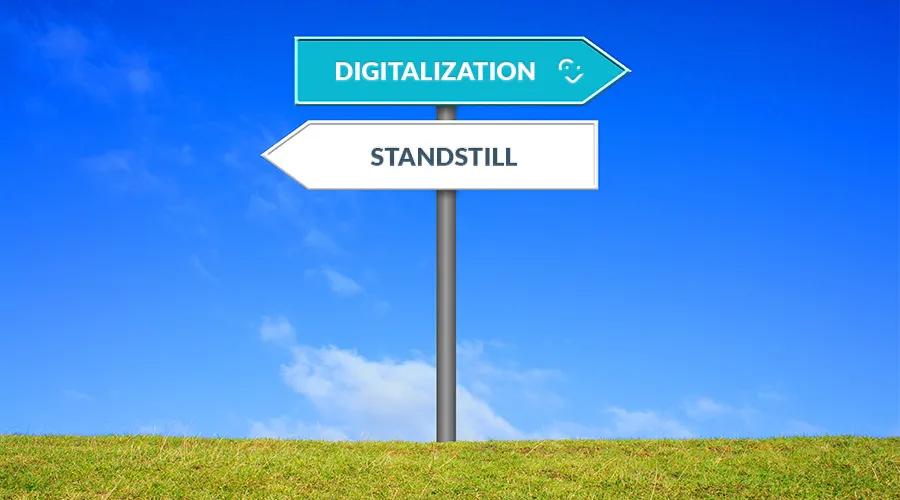Focusing on
the People And anchoring Changes in the Long Term
the
In a business environment that is constantly changing, you need a targeted approach to manage the whole thing efficiently. Change management is used to initiate, manage and control major changes in the company. It’s not just about implementing new solutions, but also about changing ways of thinking sustainably and taking full advantage of the benefits of change. 🦋
“The Rest will work itself!”
Imagine this situation: as your company is slowly but surely growing and your team is working remotely more often, you need a new communication tool for your online meetings that is designed for more users. Your search is based on three parameters: cost, quality and ease of use. After several weeks of research, countless tested demo versions and online training courses, you have finally found a suitable tool.
Now, we just need to introduce the tool to the company and let the team know.
Unfortunately it’s not that simple!
Changes according to the Plug-and-play Principle?
If you want to use an external peripheral device (e.g. a headset or a mouse), it is often sufficient to simply connect it to the PC. You don’t need to do much more. Since change processes, such as the introduction of a new communication tool, unfortunately do not work according to the simple plug-and-play principle, you need change management as an effective instrument in the company to handle them properly.
What is Change Management? - a Definition
Change management is there to initiate, manage and control (major) changes within your company. The term was used by American scientists as early as the 1930s. Here is a simple definition:
Change management stands for the planned and controlled implementation of certain measures, tasks, projects or activities in order to profoundly change individual departments or the entire company.
Change - what is it anyway?
In a company, change can be virtually anything - from changing the online meeting tool to introducing ergonomic standing desks. Put simply, you could say that change is when something is one way and then isn’t (or vice versa).
Or something more specific: A change describes the transformation from an (old) state to a new or different state.
When do Companies need Change Management?
Basically, companies have to permanently adapt to new circumstances - change happens all the time. After all, “change is the only constant”.
However, when the internal framework conditions and/or the external environmental influences change particularly quickly, companies are even more dependent on target-oriented change management.
The most common occasions include:
- Digitalization of business processes / digital transformation
- Introduction of new IT systems
- Adaptation of the corporate strategy
- Establishment of new (agile) organizational structures
- Company growth or increase in complexity
- Optimization of processes and procedures
- Development of new markets
- Internationalization/global rollout
- New competitive situation or increased competitive pressure
- Mergers and acquisitions (M&A activities)
- Sustainability, reduction of resource consumption
- New expectations of employees
- Personnel changes (e.g. high fluctuation)
- Political requirements (e.g. new regulations)
A profound Transformation Process: changing Mindsets, too
A change process is a transformation process and the mindset plays a major role in its success. It’s not about simply providing a new software solution or product, but about sustainably changing and anchoring the associated ways of thinking and fully understanding the benefits of the change. This is the only way your company can evolve.
The famous Irish writer George Bernard Shaw put it in a nutshell:
Progress is impossible without change; and if you can’t change your way of thinking, you can’t change anything.

(Small) Mistakes are Part of the Process
Whenever you try something new, mistakes will happen. Mistakes must even happen! Preferably not big mistakes, of course, but ones that do not cause serious damage and from which you learn something for the future.
Too much fear of mistakes in turn stands in the way of your growth. Always give new creative ideas a chance first. To do this, it is best to remove the automatic, intuitive “Yes, but…” from your vocabulary. 😉
The Change Curve: a Change usually takes Place in seven Phases
When you announce a change, you usually experience a negative reaction at first: many of the employees are shocked and reject the change. Until the change is fully integrated into the company, they have to go through several phases with ups and downs.
The special Task of Management
Managers are also moving along the change curve. However, they have a time head start - so they can act as a role model for employees. Because only if the management is enthusiastic about the change and can convey this enthusiasm can it be transferred to the entire team. An important aspect is to make the added value visible to everyone by training management in advance so that they have the necessary key skills. The whole thing can sometimes work without training, but this requires a lot of courage!
The five Roles of Managers
Basically, managers have five key roles in the change process: for example, they become “change ambassadors”. With the help of role-specific tasks, they support employees, depending on the challenge they are facing.
Project Sponsorship or Paper Tiger?
The person responsible for project sponsorship has a central function in this context. The best person for this role is someone who holds a high position in the company, e.g. the CEO. This person should also have a strong, present demeanor and be decisive. Otherwise they may just be a paper tiger.
Problems and Resistance in Change Processes
Around 75 to 80 percent of all change projects fail. The causes are often human-related. To prevent failure, you should address why your employees are resisting change and what you can do about it at an early stage.
One of the reasons is “not knowing”: employees have not yet realized what advantages the change will bring. That’s why, it is important to support them and involve them right from the start. A well-chosen project name can also contribute to a successful announcement and communication of the change project.
Change Management vs. Project Management
Both project management and change management play central roles in the company.
Project management is about dealing with a specific issue or acute problem, with the focus on the departments in the company that are affected. Change management involves the entire company, including all structures and processes. Project management can therefore support change management.
Change managers usually have different professional backgrounds and no uniform CV. What both disciplines have in common: those responsible should have experience in order to be able to assess the scope of decisions well.
Don’t just pour old Wine into new Bottles!
If you only focus on optimizing your existing structures and processes as part of your change management, this will probably not be enough for your long-term success. Metaphorically speaking, that would be the same as pouring old wine into new bottles. Rather, it’s about leaving the old rut and breaking new ground.
More information
on the topic Change Management
on the


 Focus on People
Focus on People



















